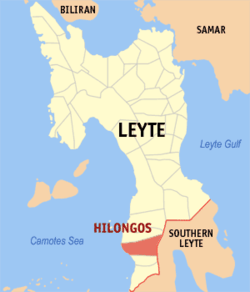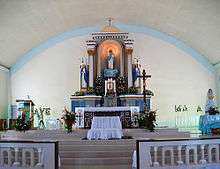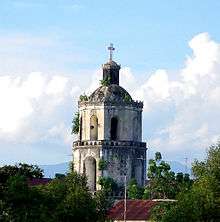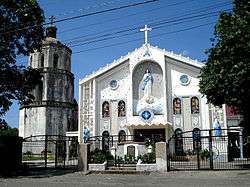Hilongos, Leyte
| Hilongos | ||
|---|---|---|
| Municipality | ||
|
Immaculate Conception Parish Church | ||
| ||
 Map of Leyte with Hilongos highlighted | ||
.svg.png) Hilongos Location within the Philippines | ||
| Coordinates: 10°22′N 124°45′E / 10.367°N 124.750°ECoordinates: 10°22′N 124°45′E / 10.367°N 124.750°E | ||
| Country | Philippines | |
| Region | Eastern Visayas (Region VIII) | |
| Province | Leyte | |
| District | 5th district of Leyte | |
| Established | 1737 | |
| Barangay | 51 (see Barangays) | |
| Government | ||
| • Mayor | Albert Villahermosa (LP) | |
| • Vice mayor | Manuel Gabisan | |
| • Council |
Members
| |
| Area[1] | ||
| • Total | 192.92 km2 (74.49 sq mi) | |
| Population (2015 census)[2] | ||
| • Total | 63,431 | |
| • Density | 330/km2 (850/sq mi) | |
| Demonym(s) | Hilongosnon | |
| Time zone | PST (UTC+8) | |
| ZIP code | 6524 | |
| IDD : area code | +63 (0)53 | |
| Income class | 2nd class | |
Hilongos is a second income class municipality in the Province of Leyte, Philippines. Hilongos shares its border with the Municipality of Hindang in the north, the Municipalities of Sogod (Southern Leyte) and Bontoc (Southern Leyte) in the east, the Municipality of Bato in the south and the Camotes Sea in the west. According to the 2015 census, Hilongos has a population of 63,431 [2]. Hilongos is the biggest municipality in terms of income, population and area in the south-western part of Leyte, a string of five (5) equidistant and progressive municipalities namely, Inopacan, Hindang, Hilongos, Bato and Matalom comprises the south-western part of Leyte. Hilongos is the center for commerce, education, government and ecclesiastical offices, health facilities, rice production, sports, shipping, socio-cultural activities and telecommunications in the south-western part of Leyte. The Port of Hilongos is one of the biggest and busiest in Leyte. Also, Hilongos is equipped with an airport, which can be more helpful and useful if improved. At present, Hilongos has two (2) public markets, the old one and the new one respectively. The Municipality of Hilongos is composed of fifty-one (51) strong barangays with vast coastal plains used mainly in the production of rice.
Barangays
Hilongos comprises 51 barangays:[3]
- Agutayan
- Atabay
- Baas
- Bagong Lipunan (BLISS)
- Bagumbayan
- Baliw
- Bantigue
- Bon-ot
- Bung-aw
- Cacao
- Campina
- Cantandog 1
- Cantandog 2
- Concepcion (Makinhas)
- Hampangan
- Himo-aw
- Hitudpan
- Imelda Marcos (Pong-on)
- Kang-iras
- Kanghaas
- Lamak
- Libertad
- Liberty
- Lunang
- Magnangoy
- Manaul
- Marangog
- Matapay
- Naval
- Owak
- Pa-a
- Central Poblacion (Town Proper)
- Eastern Poblacion (Town Proper)
- Western Poblacion (Town Proper)
- Pontod
- Proteccion
- San Agustin
- San Antonio
- San Isidro
- San Juan
- San Roque (Taganas)
- Santa Cruz
- Santa Margarita
- Santo Niño
- Tabunok
- Tagnate
- Talisay
- Tambis
- Tejero
- Tuguipa
- Utanan
History


Lore has it that in the 12th century, Amahawin, an Ilonggo from Iloilo, conquered neighboring barangays on Leyte’s western shore and extended his territory to the present limits of Inopacan, Hindang, Bato, and Matalom. He formed a settlement and named it Hilongos, because its inhabitants were Ilonggos.
In 1710, the Jesuits created a residence there. In 1737, according to Redondo 1886:207, Hilongos was already a parish before this year. However, Braganza (1965) claims that Hilongos became a parish only in 1737. This date corresponded to the establishment of the town.(Tantuico 1964:41)
1754 was the date of the oldest parish books (deaths) as of 1884.
In 1768, the Jesuits ceded Hilongos to the Augustinians. In 1774–79, the Augustinians established schools in Hilongos. In 1784, Palompon, a Hilongos visita, became an independent parish.
In 1862, Manicar led a revolt at Barrio Sta. Margarita.
In 1873, Leovio Magia led a revolt. Unlike the towns of eastern Leyte, which were ceded to the Franciscans in 1843, the towns along Leyte’s western coast fell one by one under the seculars.
Demographics
| Population census of Hilongos | ||
|---|---|---|
| Year | Pop. | ±% p.a. |
| 1990 | 48,617 | — |
| 1995 | 50,744 | +0.81% |
| 2000 | 51,462 | +0.30% |
| 2007 | 53,911 | +0.64% |
| 2010 | 56,803 | +1.92% |
| Source: National Statistics Office[4][5] | ||
Heritage sites
Church complex—The present church’s bell tower is attributed by Redondo to a secular Don Leonardo Celis-Díaz, a native of Cebu. The building of the church fabric itself is disputed. Did Celis-Díaz build it or did he merely repair an older structure left by the Jesuits? Oral lore claims that the church and the ruined convento behind it are from the Jesuits; but Repetti reports otherwise. Certainly, there must have been some permanent structures when Hilongos became a residence.
It is quite clear that the church complex underwent major renovations over the centuries. The original church, now incorporated as a transept, was a single-nave structure whose main door was also the gate to a bastioned fortification. Some bastions and walls of that fortification still remain. The main nave of the church is a modern construction, and the bell tower build by Fr. Celis-Diaz is an independent multi story structure, now plastered over with Portland cement.
The church interior is completely new in contrast to the convento which may have been completed in the 19th century. The convento guards many of the church’s antiques including silver vessels from the 18th century.
Transport facilities
Shipping companies
- Roble Shipping Inc.: Ro-Ro/Passenger/Cargo service, day & night trips to Cebu City and vice versa
- Gabisan Shipping Lines Inc.: Passenger/Cargo service, day & night trips to Cebu City and vice versa
- Leopards Motorboat Service: daily trips to Ubay, Bohol and vice versa
Land
- Main Type of Transportation: Bus/Mini-Bus/Van
- Route: Hilongos-Tacloban, Hilongos-Ormoc/Baybay, Hilongos-Maasin
- Boat Service: for Hilongos-Cebu (vice versa), Hilongos-Ubay, Bohol (vice versa)
- Other Types of Land Transport Facilities: Tricycles (Sidecars), Multicabs (PUJ's), Trisikad or locally called as "Pot-pot" and also "Habal-habal" a motorcycle that is used as a main and easy way of transportation on the mountainous parts of Hilongos.
Air
| Hilongos Airport | |
|---|---|
| Type of Airport | Emergency |
| Location | Eastern Poblacion, Hilongos, Leyte |
| Total Area | 17 hectares (42 acres) |
| Distance from Pob. | 1 kilometre (3,300 ft) |
| Airport Apron | 2,400 m2 (25,830 sq ft) MAC (Macadam) |
| Airport Runaway | 1,000 m × 30 m (3,280 ft × 100 ft) (Macadam) |
| Airport Classification | Feeder |
Education
Tertiary
- MLG College of Learning (MLGCL)
- Virginia Institute of Technology (VIT)
Secondary
- Hilongos National Vocational School (HNVS)
- Saint Teresa School of Hilongos (STSH)
- Grelina Osmeña Christian College (GOCC)
- MLG College of Learning (MLGCL)
- Naval National High School
- Bung-aw National High School
- Sta. Margarita National High School
- Concepcion National High School
- Hitudpan National High School
Health care
- Hilongos District Hospital
- RHU I (Poblacion)
- RHU II (Concepcion)
- Leyte Baptist Hospital
- Villaflor's Clinic and Hospital
- Sto. Nino Clinic
- Klinika Zamoras
- Dipon Dental Clinic
- S.H. Nevado Dental Clinic
- Other Medical and Dental Clinics
References
- ↑ "Province: Leyte". PSGC Interactive. Makati City, Philippines: National Statistical Coordination Board. Retrieved 2 July 2013.
- 1 2 "Region VIII (EASTERN VISAYAS)". Census of Population (2015): Total Population by Province, City, Municipality and Barangay (Report). PSA. Retrieved 20 June 2016.
- ↑ Philippine Standard Geographic Code listing for Hilongos - National Statistical Coordination Board
- ↑ "Region VIII (EASTERN VISAYAS)". Census of Population and Housing (2010): Total Population by Province, City, Municipality and Barangay (Report). NSO. Retrieved 29 June 2016.
- ↑ "Region VIII (EASTERN VISAYAS)". Census of Population (1995, 2000 and 2007): Total Population by Province, City and Municipality (Report). NSO. Archived from the original on 24 June 2011.
- Braganza, José Vicente (1965). Story of Leyte. DWU (Divine Word University). Tacloban: unpublished.
- Sendino y Redondo, Felipe (1886). Breve reseña de lo que fue y de lo que es la Diócesis de Cebú en las Islas Filipinas (in Spanish). Manila: Colegio de Sto. Tomas.
- Tantuico, Francisco Sypaco (1964). Leyte : the historic islands. prefaced by Carlos P. Romulo. Tacloban: Leyte Pub. Corp.
External links
| Wikimedia Commons has media related to Hilongos, Leyte. |
 |
Hindang | Sogod, Southern Leyte |  | |
| Camotes Sea | |
Bontoc, Southern Leyte | ||
| ||||
| | ||||
| Bato |

